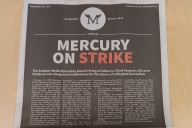You have /5 articles left.
Sign up for a free account or log in.
 Katie Shives is a PhD candidate in Microbiology at the University of Colorado. During her free time she writes about microbiology-related topics at kdshives.com and on Twitter @KDShives.
Katie Shives is a PhD candidate in Microbiology at the University of Colorado. During her free time she writes about microbiology-related topics at kdshives.com and on Twitter @KDShives.
There is a big difference between the research posters we make in graduate school compared with our seventh grade science projects. Some of us, myself included, managed to dodge poster projects all through undergrad, until one day as graduate students we find ourselves staring blankly at the submission form for a poster session at a conference.
Thankfully, posters are not as hard to make as they might seem, but there are some very common mistakes that many people make when putting together their first posters. Here are some basic pointers I have picked up that have greatly helped me with putting together and presenting posters.
1. Focus your message: Poster size is limited, so you really need to take the time to determine what point you want to convey. What data do you need to include to get your specific message across to an audience unfamiliar with your work? What is the minimum amount of information that you need to create a convincing narrative for your work? If you find yourself going under 18pt text to fit it all in, you’ve gone too far and need to start cutting back.
2. Keep it Simple: In order to not overwhelm your audience, don’t cram your poster edge-to-edge with tiny, dense text and a dozen hard to decipher figures. We have all seen that poster, and it is impossible to read. Use only the data and text that you need to support your conclusions. You can communicate anything else that is relevant in your poster talk (see tip #5).
This also applies to the visual design of your poster. Don’t get too carried away with bright colors and fancy design as these can be very distracting. It can be tempting to go overboard on the design, so try to screen design elements by whether or not they enhance the content you are presenting. Never underestimate the value of blank space on your poster as well. Good design should fade into the background so that your work can be clearly interpreted.
3. Arrange figures for maximum impact: Viewers usually expect the most important part of the poster to be right in the middle, so keep the most important parts in a central area. This usually includes experimental figures for a research poster. Once you have the “meat” of the poster set you can add in other sections (Introduction, Conclusions, Methods, Acknowledgements, etc) around the periphery.
Most graduate departments should have some posters on hand from current students, so if you are at a loss on how to arrange your content, take a moment to look at the posters that fellow students in your field have made to get a feel for what the standards are.
4. Know your audience: Posters are a short story designed to visually convey your work to an audience. It is important to know who that audience is and what they expect from your poster. Is it a more general poster session? Then keep your information more generalized. Is it a conference for a specific subsection of your discipline where everyone knows the same jargon and industry leaders? Then by all means go deep into the technical details--if it doesn’t crowd your poster.
5. Hone your poster talk: Usually, you will have the opportunity to present your poster during a designated poster session, so take some time to plan out your talk. When putting together your talk, take a moment to think about what you want to convey.What is on your poster and what is your message? How do you convey your research/concept to your specific audience? Is there anything that you need to mention that you didn’t have room to include on the poster?
Because you won’t have a guide on the poster to remember these additional points, it is helpful to rehearse your talk ahead of time and make up a card with prompts that connect your poster to related points you want to make, but might not remember on the fly.
Conclusions:
Poster sessions can be fun and less stressful than an oral presentation for those of us who have difficulties with public speaking. They also provide opportunities for one-on-one interactions with individuals in your field and can facilitate high-quality networking that will benefit you and your future career.
While these are some basic tips, there are more in-depth guides to poster design on the internet. One that I highly recommend is “Scientific Poster Design” by the Cornell Center for Materials Research. This site shows many different types of posters and some of the most common pitfalls that occur during poster design.
Do you have any “tried and true” approaches to designing great conference posters? Please share them in the comments section below!
[Image by Flickr user NASA Goddard Space Flight Center used under creative commons licensing.]








